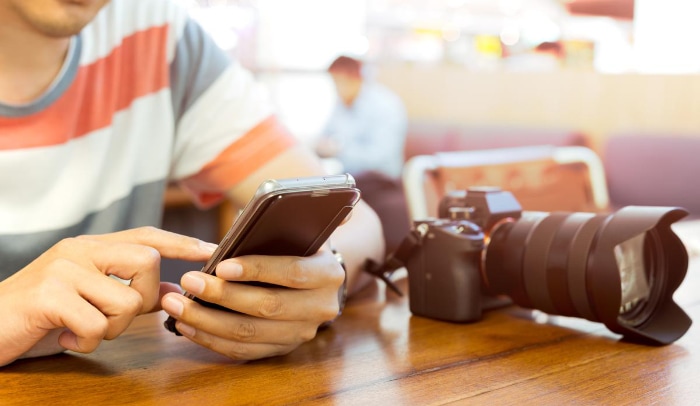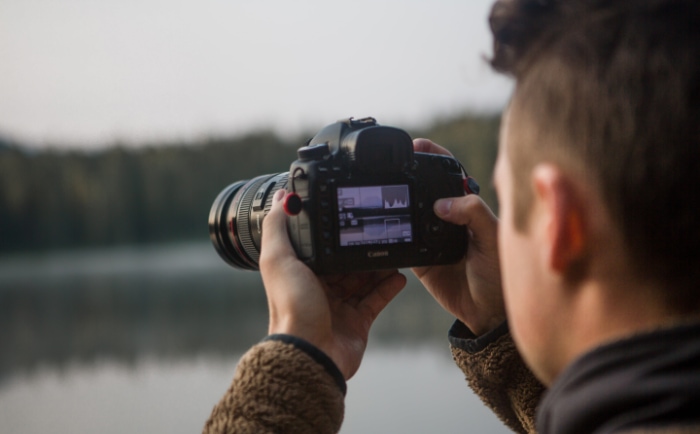Smartphone Cameras vs. DSLRs: Choosing Your Gear

Photography has undergone a profound transformation over the past two decades. From the era where bulky equipment ruled the scene, we've transitioned to a time where powerful camera technology fits right into our pockets.
This shift has ignited a passionate debate: Can smartphone cameras rival the prowess of DSLRs? As we navigate through this discourse, we'll uncover the distinctive attributes and potential constraints of each.
Understanding the Basics
The world of photography is vast and diverse, with various tools designed to cater to different needs. At the foundation of this world lie two prominent players: smartphone cameras and DSLRs.
Smartphone Cameras
Often the more accessible tool for the average person, smartphone cameras have made significant strides in recent years.
- Core Components
- Sensor: Often smaller than DSLRs but has witnessed advancements in terms of quality and light sensitivity.
- Lens: Fixed but can often switch between multiple lenses like ultra-wide, wide, telephoto, and macro on advanced models.
- Processor: Critical for speedy image processing and enabling features such as HDR and night mode.
- Features and Capabilities
- AI Enhancements: Many modern smartphones use artificial intelligence to optimize shots, identify subjects, and even enhance photo quality.
- User Interface: Designed for ease of use with touch controls, sliders, and immediate access to various settings.
- Integration: Built-in capabilities for instant sharing, editing, and cloud storage.
Digital Single-Lens Reflex (DSLR) Cameras
A preferred choice for many professionals and enthusiasts, DSLRs offer unparalleled control and versatility in the photography realm.
- Core Components
- Sensor: Larger in size, resulting in better image quality, especially in low-light conditions.
- Lens: Interchangeable, allowing for a wide variety of shots from wide-angle landscapes to detailed macro shots.
- Processor: Engineered for optimal image processing, especially important for high-resolution shots and RAW images.
- Features and Capabilities
- Manual Controls: Provides the ability to adjust settings like shutter speed, aperture, and ISO for precise shot composition.
- Viewfinder: Allows for real-time, through-the-lens viewing, ensuring the shot is exactly as the photographer envisions.
- Extended Battery Life: Designed for prolonged usage, especially beneficial for events and lengthy shoots.
Advantages of Smartphone Cameras
The advent of smartphone cameras has revolutionized the way we capture and share moments. With the convenience of being pocket-sized, these devices pack a powerful punch in the world of photography.
Portability and Convenience
Smartphones are an integral part of our daily lives, always within arm's reach. Their compact design means you're always ready to snap a photo without the need for bulky equipment.
Seamless Connectivity
With built-in internet capabilities, smartphone cameras allow for instant photo sharing on social media platforms, email, and more. This feature bridges distances and aids in real-time collaboration and feedback.
Intuitive User Experience
Modern smartphone camera interfaces are designed with user-friendliness in mind. Touch controls, easy-to-use sliders, and automatic modes simplify the process for both novice and experienced users.
Innovative Features
The technology packed into these small devices is impressive. Many come equipped with features such as:
- AI Enhancements: These optimize shots, identify subjects, and improve photo quality based on the scene.
- Versatile Lenses: Advanced models switch between lenses like ultra-wide, wide, telephoto, and macro, offering varied perspectives.
- Night Modes: Designed to enhance low-light photography, giving photos clarity even in less than ideal lighting conditions.
Integration with Apps
The vast array of photography apps available enhances the capabilities of smartphone cameras. From advanced editing tools to niche filters and effects, users can elevate their photography game effortlessly.
Cost-Effectiveness
For many, a high-quality smartphone camera negates the need for a separate camera device. This dual utility—communication device and camera in one—provides value for money.
With these advantages in hand, it's clear to see why smartphone cameras have become a popular choice for many. Their blend of convenience, advanced tech, and user-friendly design caters to a wide range of photography enthusiasts and professionals alike.
Advantages of DSLRs
Digital Single-Lens Reflex (DSLR) cameras have long been a cornerstone in the world of photography. Their reputation is built on a combination of versatility, image quality, and the freedom they offer to photographers.
Superior Image Quality
DSLRs typically come equipped with larger sensors. This allows them to capture more light, details, and colors, resulting in sharper images with greater depth and clarity, especially in challenging lighting conditions.
Interchangeable Lenses
The ability to change lenses provides photographers with unparalleled versatility. Whether capturing sweeping landscapes with a wide-angle lens or intimate wildlife shots with a telephoto, the possibilities are vast and varied.
Advanced Manual Controls
DSLRs grant photographers full control over their shots, allowing shutter speed, aperture, and ISO adjustments. This precision ensures that photographers can achieve their envisioned results, whether it's freezing motion or creating a beautiful bokeh effect.
Durability and Build
Often constructed with robust materials, DSLRs are designed to endure the rigors of fieldwork. Their build quality can withstand various weather conditions, and some models are even dust and water-resistant.
Viewfinder Precision
Using a through-the-lens optical viewfinder, photographers can see a scene in real-time without any electronic delay or lag, ensuring that the final image aligns perfectly with the viewed scene.
Extended Battery Life
DSLRs are engineered for prolonged shoots. Their battery life often outlasts that of smartphones, which is crucial for events, wildlife photography, or any scenario where charging frequently isn't feasible.
Expandable Accessories
A world of accessories is available for DSLRs, from specialized flashes and filters to stabilizing rigs and external microphones for video capture. This expandability allows photographers to customize their setup according to specific needs.
RAW Image Capture
DSLRs often support shooting in RAW format. This captures all image data from the sensor, providing greater flexibility in post-processing and ensuring the highest quality final product.
Recognizing these benefits provides clarity on why DSLRs continue to hold their ground in the face of rising smartphone camera popularity. They cater to both seasoned professionals and budding enthusiasts, offering tools and features that elevate the art of photography.
Considerations for Different Use Cases

Choosing between a smartphone camera and a DSLR often depends on the specific scenario or purpose of photography. Each tool has its strengths, and the ideal choice can vary based on the requirements of a particular situation.
Here's a closer look at how both fare in diverse photographic settings.
Travel Photography
Traveling light can make journeys more comfortable. In such cases, smartphone cameras often come out on top due to their compact nature.
However, a DSLR might be worth the extra weight for those who prioritize image quality and versatility over convenience.
Portrait Photography
When it comes to portraits, the depth of field becomes significant. With their larger sensors and lens options, DSLRs can create a beautiful blur in the background, making the subject stand out.
While some smartphones offer portrait modes that mimic this effect, they often don't match the organic quality a DSLR can provide.
Event Photography
Events, especially those indoors or in the evening, require optimal low-light performance. DSLRs have the edge here with their larger sensors and superior manual controls.
That said, high-end smartphones are making strides in low-light capabilities, but a flash's adaptability and power with a DSLR remain unmatched.
Street Photography
For street photographers, discretion is key. A smartphone is less intrusive and can often help capture candid moments without drawing attention.
However, for those seeking the highest quality street shots, a compact mirrorless camera or a DSLR might still be the tool of choice.
Wildlife Photography
Wildlife photography demands zoom capabilities and speed. DSLRs, especially when paired with telephoto lenses, provide the range necessary to capture distant subjects in sharp detail.
While some smartphones boast impressive zoom features, they often employ digital zoom, which can degrade image quality.
Landscape Photography
Landscapes require sharpness across the frame and often benefit from specific lens choices. DSLRs offer the flexibility of wide-angle lenses that can capture vast scenes in stunning detail.
While smartphones can capture impressive landscapes, especially with newer ultra-wide lenses, a DSLR's dynamic range and detail often stand out.
Macro Photography
Close-up shots or macro photography reveal intricate details. While many smartphones now offer macro modes, DSLRs with dedicated macro lenses provide greater magnification and detail.
Understanding the specific demands of each photographic scenario can guide the choice between a smartphone camera and a DSLR. Both have their places in the world of photography, and the best tool often depends on the task at hand.
Economic Considerations
When it comes to photography, the adage “you get what you pay for” often holds true. However, the best choice isn't always the most expensive one.
Instead, the ideal camera often aligns with one's budgetary constraints and specific needs. Let's examine the economic aspects of choosing between smartphone cameras and DSLRs.
Initial Investment
Smartphone Cameras
Buying a top-tier smartphone with an advanced camera system can be pricey, but it's essential to remember that the device also serves multiple other functions, from communication to entertainment. This multi-functionality offers inherent value, even if the upfront cost seems steep.
DSLRs
A basic DSLR kit can be relatively affordable, but prices can soar when investing in professional models. It's also worth noting that the initial purchase might include just the camera body, necessitating separate expenditure on lenses.
Long-Term Costs
Smartphone Cameras
With smartphones, there aren't many additional costs involved specifically for photography after the initial purchase. However, it's worth considering the device's lifespan, which might be shorter than a dedicated camera due to battery degradation or software updates.
DSLRs
While the camera body can last long, lenses, memory cards, external flashes, and other accessories might require additional investment. Maintenance, such as sensor cleaning, can also add to long-term costs.
Resale Value
Smartphone Cameras
Smartphones tend to depreciate faster than DSLRs. Even top-tier models might lose significant value within a year or two, especially with frequent new releases from manufacturers.
DSLRs
Quality DSLRs and lenses often hold their value better, especially if well-maintained. Some sought-after lenses might even appreciate in value or remain stable over time.
Versatility vs. Niche Needs
Smartphone Cameras
A smartphone offers great economic sense for those who need a versatile tool for various tasks beyond photography. It consolidates multiple devices into one, potentially saving money in the long run.
DSLRs
The DSLR's adaptability can be economical for individuals focused on specific photography niches. Instead of buying a new camera for different needs, one can invest in lenses or accessories tailored to those requirements.
Conclusion
Photography offers a unique blend of art and technology, with tools ranging from pocket-sized smartphone cameras to robust DSLRs. Each has carved its niche, catering to various user needs and preferences.
Smartphone cameras champion convenience, connectivity, and multi-functionality, making them ideal for the everyday photographer and those on the go. On the other hand, DSLRs provide unparalleled image quality, versatility, and control, appealing to professionals and enthusiasts alike.
Economic considerations further complicate the decision, with both options presenting varying initial investments and long-term costs. Ultimately, the best choice hinges on individual priorities, be it budget, image quality, or sheer convenience.
With either tool in hand, capturing life's moments has never been more accessible or rewarding.


